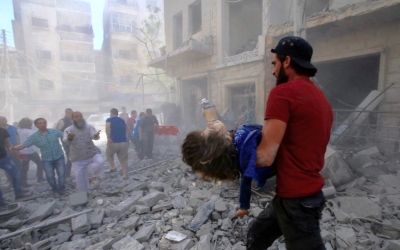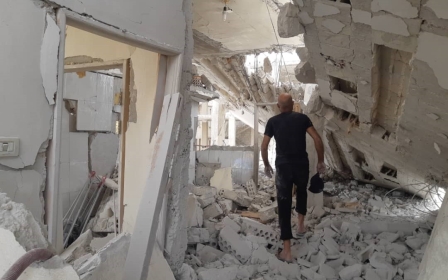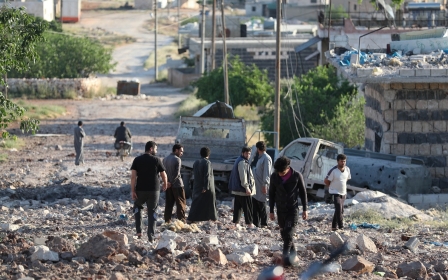UN calls for action as Syrian government air strikes kill dozens in northwest

A United Nations official has called for "concrete action", as Syrian government air strikes killed at least 27 people in the country's rebel-held northwest, according to a pro-opposition war monitor.
The Syrian Observatory for Human Rights said 11 children were among the more than two dozen civilians killed in air strikes on Tuesday, which hit several towns in Idlib province and the countryside of neighbouring Aleppo.
The attacks come as pro-government troops intensified their recent bombardments of the country's northwestern region, which is mostly under the control of al-Qaeda-linked Hay'at Tahrir al-Sham (HTS).
"Can't this council take any concrete action when attacks on schools and hospitals have become a war tactic that no longer sparks outrage?" said Ursula Mueller, the UN's assistant secretary-general for humanitarian affairs, in a briefing to the UN Security Council on Tuesday.
"Is there nothing to be said or done when indiscriminate barrel bombs are dropped in civilian areas?" Mueller continued.
New MEE newsletter: Jerusalem Dispatch
Sign up to get the latest insights and analysis on Israel-Palestine, alongside Turkey Unpacked and other MEE newsletters
"Millions of battered and beleaguered children, women and men cannot wait for another Geneva round [of negotiations] to succeed. They need protection - and your action - now."
Of the people killed on Tuesday, nine were struck on a busy street in the village of Kafr Halab, on the western edge of Aleppo province, AFP news agency reported.
David Swanson, a spokesman for the UN humanitarian office told the agency that a hospital in the Idlib town of Kafranbel was also bombed.
"The facility is reportedly out of service due to severe structural damage," he told AFP.
"It was a strong attack," Swanson added. "The generators and even my car caught fire."
The United States on Tuesday issued a warning against the Syrian and Russian air strikes in northern Syria.
"Indiscriminate attacks on civilians and public infrastructure such as schools, markets and hospitals is a reckless escalation of the conflict and is unacceptable," said State Department spokeswoman Morgan Ortagus.
Increase in bombings
Tuesday's strikes follow two days of increased government bombings in the area, which have killed 52 people, according to the UK-based Observatory.
Since late April, Syrian and Russian forces have focused efforts mostly on southern parts of Idlib province and adjacent parts of Hama and Latakia, where HTS and other armed groups maintain control.
Syrian state media outlets say that the escalation is intended to target "terrorist groups" present in the region.
In September 2018, Turkey and Russia reached a ceasefire deal that maintained relative peace between the government and rebel groups in the region for several months.
But over the past weeks, the Syrian government and Russia have renewed their attacks on Idlib in what opposition activists call a violation of last year's agreement.
The violence has left 834 people dead since 30 April, the Observatory said in a report released earlier this week.
Anti-government activists accuse Damascus of targeting civilians.
A government air strike killed "11 civilians, including six children and four women" in the village of Ariha on Monday, according to "White Helmets" first responders in the town.
"Attacks on a civilian neighbourhood were launched near the popular market during noon prayers," activist Fares Zine al-Abidine told Middle East Eye after the attack on Ariha.
"Panic and fear took hold of the city and the smell of gunpowder and blood rose from the blast site as fears of a second attack grew."
New satellite images also showed fields, orchards and olive groves burning in northwest Syria, Reuters reported on Tuesday.
Plumes of dark smoke could be seen in the photos, taken by satellite imagery provider DigitalGlobe Inc, in the countryside around al-Habeet village in Idlib and the small town of Kafr Nabouda in Hama, the news agency said.
Reuters reported that the before and after images, collected at the start and end of last week, show patches of scorched earth, fields blackened by fire, and clusters of destroyed buildings.
Some of the fires appeared to be still burning on Tuesday, Reuters said.
Middle East Eye delivers independent and unrivalled coverage and analysis of the Middle East, North Africa and beyond. To learn more about republishing this content and the associated fees, please fill out this form. More about MEE can be found here.






